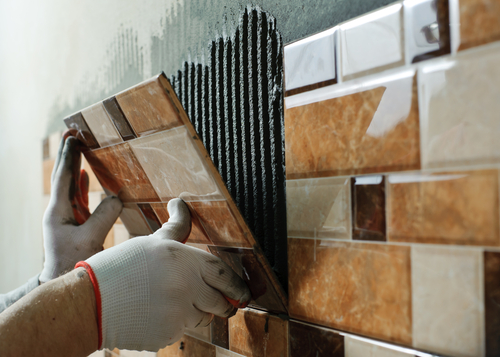It’s finally time to start your remodeling project! You likely have been gaining inspiration through different style ideas so that you can best bring your vision to life. While searching, you have probably seen hundreds of examples of tile work and wondered which tile option will be best suited for your project.
First things first, there are a lot of different tiles that you can choose from. In addition, each tile material has different price ranges and different properties. Due to these various properties, not every type of tile is suitable for every project, and it is essential to understand this before making any installations.
We created a list of popular titles to help guide you through understanding different tile materials and their best uses:
Ceramic Tiles
Ceramic is one of the most well-known tiles for any home improvement project. Because of ceramic’s large variety of applications, affordability, and durability, they are among the most popular choices when people consider which tiles to use. In addition, these tiles come in various styles and colors, making them complementary to nearly any kind of interior style. Made from clay, ceramic is highly durable, perfect for high touch point rooms like kitchens, bathrooms, and entryways. However, these tiles do not perform well in extreme heat or cold and are susceptible to water absorption. In addition, ceramic tiles can crack over time significantly if something heavy is dropped onto them. Glazed ceramic tiles can offer more excellent protection against damage or staining, yet some people will opt for unglazed tiles due to their ability to provide a more rustic look.
Porcelain Tiles
Alongside ceramic tiles, porcelain tiles are the other most commonly used tile. Porcelain is well-liked for its ability to imitate natural stone, brick, and wood without maintaining these natural materials. Porcelain also comes in a variety of designs, making it easy to adapt to various home styles. Composed of dense clay and treated at high temperatures, porcelain tiles are more sturdy and damage resistant than ceramic. Because of this durability, porcelain can also be installed in high touch point areas and even outside. What’s the catch? Porcelain tiles can be more challenging to install because of their dense and robust material, making them less suitable for a DIY project, requiring professional installation for best results.
Glass Tiles
Glass tile is a beautiful option for kitchen backsplashes due to its clean look and its high level of stain resistance. Their stain resistance even makes red wine and acidic foods easy to wipe up without leaving permanent stains. While glass is excellent for these reasons, it is not as durable as porcelain or ceramic and has chances to chip along the edges or crack if something is dropped on it. For this reason, glass tiles are best for walls and even smaller applications such as backsplashes or around fireplaces.
Cement Tiles
Cement tiles are experiencing a revival in design due to their versatility and the beautiful colors and patterns that they can offer. As cement is very porous, a natural patina can develop over time, enhancing the beautiful designs and aging these tiles beautifully. If any discoloration occurs, cement tiles can be sanded and resealed. However, cement tiles require more maintenance to maintain their beauty as they need to be resealed often. Cement can also be tough to install. For this reason, ceramic tiles may be best in small quantities in more minor trafficked areas.
Marble Tiles
Marble has withstood the test of time and is famed for the glamour and richness it can bring to any room. With its natural veining, each marble tile is unique. Though they are beautiful and make a statement, marble is rather costly and requires proper maintenance. As a porous stone, marble is prone to scratching and staining, and this porousness makes it a more difficult tile to clean. For this reason, marble is better when installed in an area with less traffic to preserve its stunning beauty.
Mosaic Tiles
Mosaic tiles are great for those interested in adding more personality with their tiles as these tiles are known for their decorative patterns, which are available in many styles, colors, and shapes. However, since mosaics can be somewhat “busy,” they look best when used in smaller amounts. Mosaic tiles commonly appear in bathrooms, kitchens, and floors. They are instead stain, moisture, and chip-resistant, making them doable for both indoors and outdoors.
Granite Tiles
Like marble, granite tiles are a natural stone with natural veining and minerals appearing in their composition, making no two granite surfaces the same. Granite is significantly more challenging than marble meaning it is less likely to chip or crack. Due to its durability, heat resistance, and property of being relatively waterproof many people choose granite for their countertops. This makes granite tiling an excellent option for areas that receive a heavier amount of traffic. However, since granite is generally larger, it is not the most cost-conscious material to choose if working on a tight budget.
Limestone Tiles
A visually pleasing natural stone, limestone comes in a variety of natural shades.
Limestone is a durable stone bringing muted earth tones to the space it is installed in. However, limestone is a porous rock meaning that it can crack if not sealed. Limestone also requires specific cleaning agents to maintain its natural beauty, making it more frustrating to clean. Limestone is beautiful wherever it is placed. Bathrooms are famous for these natural stones, but they can look great in kitchens as long as they are cared for properly.
Travertine Tiles
Travertine tiles also come in subdued natural colors, providing a natural feel to any room. In addition, travertine is rather durable, relatively easy to repair, and is also eco-friendly. Depending on the format of travertine, it can generally do well on walls, or even shower or tub surrounds. However, travertine can be impacted by other elements making it prone to staining, and while it can be cheaper than some other materials on this list, it can still be a bit expensive.
There are many different types of tile to choose from, providing a kind of tile for every taste. So whether you choose glass tile for a beautiful kitchen backsplash or marble tile to make a statement on a bathroom wall, having this knowledge about the tile types and their best uses can help you make an informed decision when designing your ideal space!
Pro Tip: Don’t forget about your setting materials!


